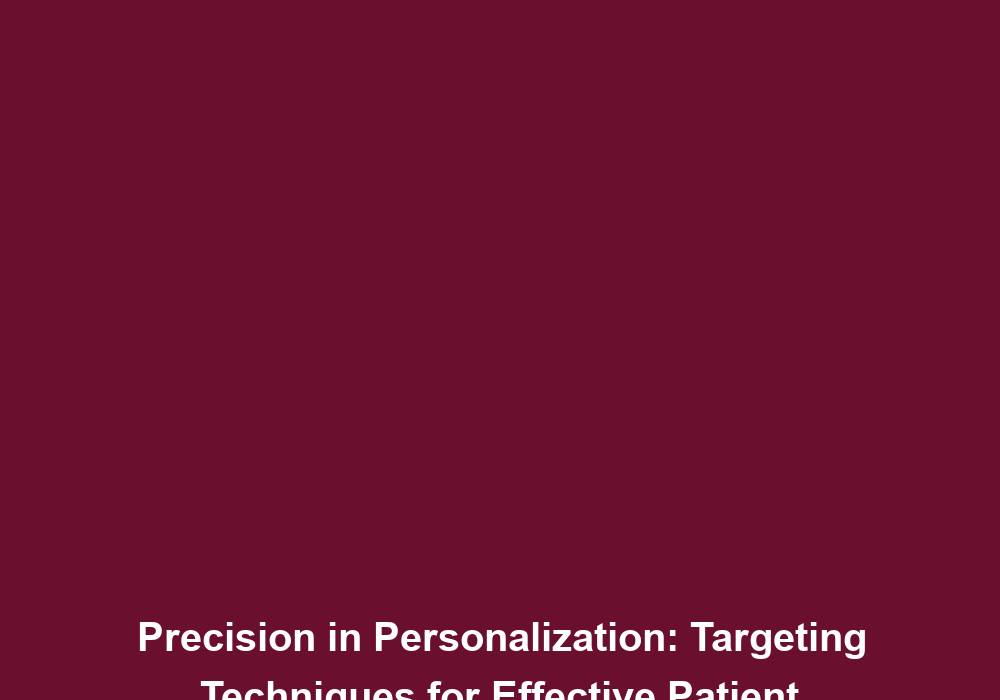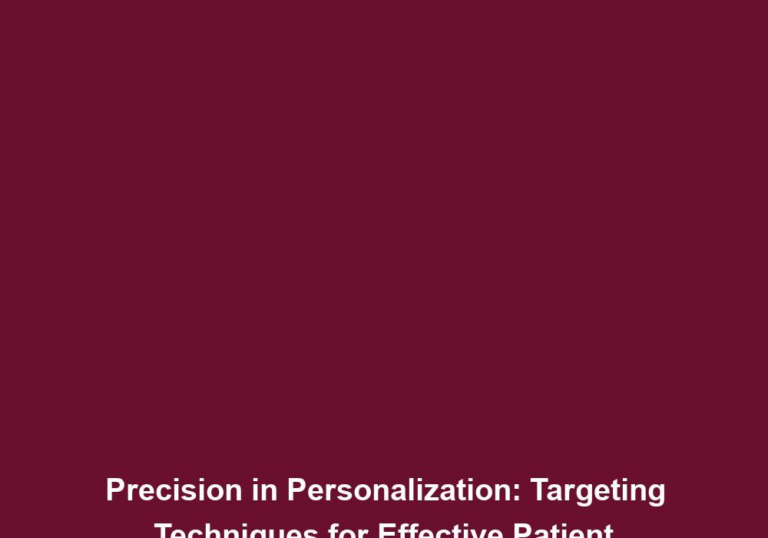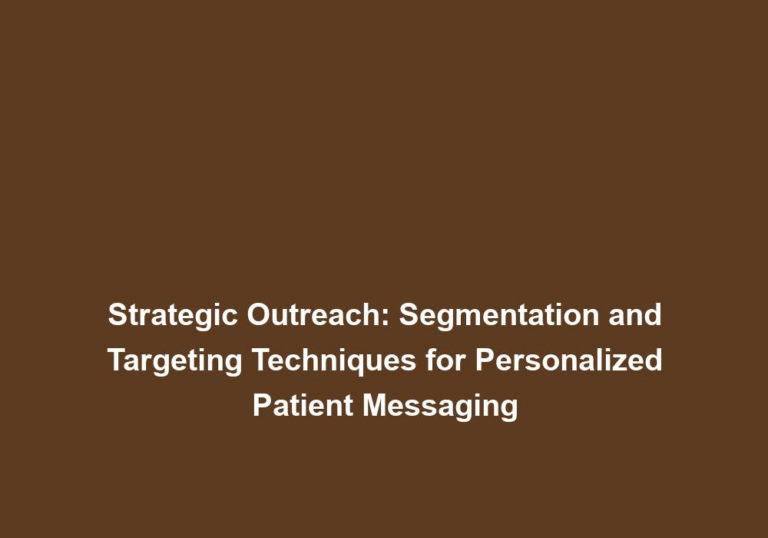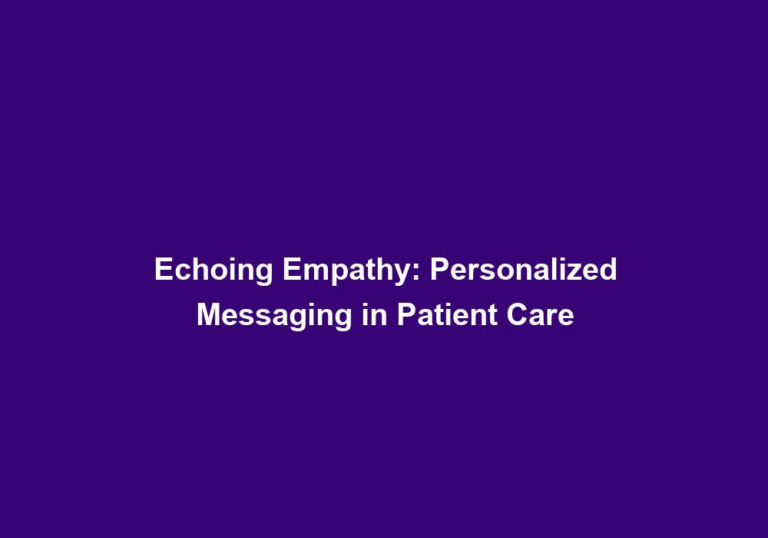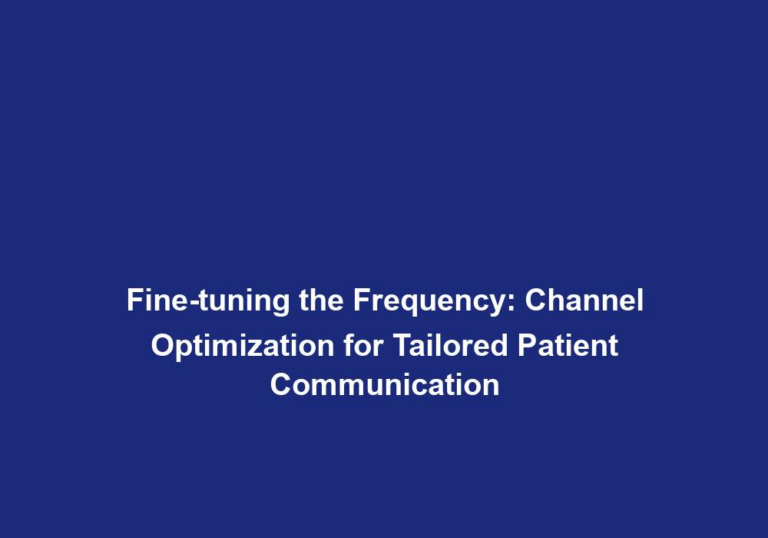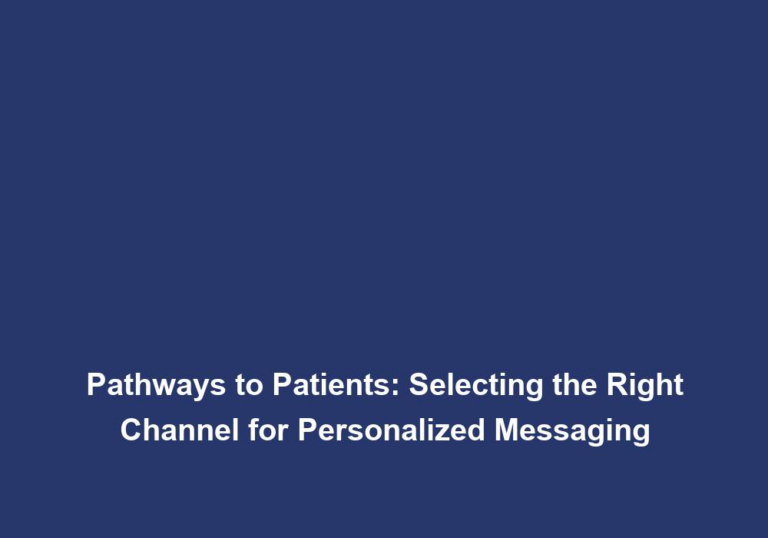Precision in Personalization: Targeting Techniques for Effective Patient Messaging
In today’s increasingly digital world, healthcare providers are faced with the challenge of effectively communicating with their patients. With the rise of personalized medicine and patient-centered care, it has become crucial to deliver tailored messages that resonate with individual patients. This article explores the importance of precision in personalization and provides valuable techniques for healthcare professionals to enhance their patient messaging strategies.
Why Precision in Personalization Matters
Personalization is no longer a luxury; it is an expectation. Patients want to feel understood and valued by their healthcare providers. By delivering personalized messages, healthcare professionals can establish stronger connections, improve patient engagement, and ultimately enhance health outcomes. Precision in personalization goes beyond simply addressing patients by their names; it involves understanding their unique needs, preferences, and circumstances.
To achieve precision in personalization, healthcare providers must adopt targeted techniques for patient messaging. Here are some strategies to consider:
1. Collect Comprehensive Patient Data
Collecting comprehensive patient data is essential for crafting personalized messages. This data can be gathered through various means, such as electronic health records, patient surveys, and online registration forms. It is crucial to include demographic information, medical history, current health conditions, preferences, and communication preferences in the collected data.
By having access to comprehensive patient data, healthcare providers can better understand their patients’ individual characteristics and tailor their messages accordingly. For example, if a patient has a specific health condition, healthcare providers can customize their messaging to address that condition and provide relevant information or resources.
2. Segment Patients Based on Relevant Criteria
Segmenting patients based on specific criteria allows for targeted messaging. By categorizing patients into groups with similar characteristics, healthcare providers can craft messages that resonate with each segment. Some common segmentation criteria include age, gender, health conditions, treatment history, and communication preferences.
Segmentation enables healthcare providers to deliver messages that are highly relevant and specific to each group of patients. For instance, if there is a new treatment option available for a particular health condition, healthcare providers can send targeted messages to patients who are affected by that condition, ensuring they receive the most up-to-date information.
3. Craft Tailored Messages for Each Segment
Once patients are segmented, healthcare providers can create tailored messages for each group. Personalizing the content based on the unique needs and preferences of each segment enhances the relevance and effectiveness of the messaging. For example, messages targeted towards elderly patients may focus on managing chronic conditions and improving quality of life, while messages for younger patients may emphasize preventive care and lifestyle choices.
Tailored messages demonstrate that healthcare providers understand their patients’ specific needs and are dedicated to providing personalized care. By addressing the concerns and interests of each segment, healthcare providers can establish a deeper connection with their patients, fostering trust and engagement.
To further enhance the impact of the messages, healthcare providers can use bullet points or lists to highlight key information or action steps. This helps patients easily digest the content and take appropriate actions as needed.
4. Utilize Multichannel Communication
Patients have varying communication preferences, and it is crucial to meet them where they are most comfortable. Utilizing a mix of channels, such as email, SMS, phone calls, and patient portals, ensures that messages reach patients through their preferred method. Additionally, utilizing multiple channels increases the likelihood of message delivery and engagement.
By offering multiple communication channels, healthcare providers can accommodate diverse patient preferences and improve the chances of successful communication. For example, younger patients may prefer receiving messages through SMS or email, while older patients may prefer phone calls or printed materials. Understanding and respecting these preferences can significantly improve patient satisfaction and overall engagement.
5. Implement Automated Messaging Systems
To streamline patient messaging, healthcare providers can implement automated messaging systems. These systems allow for personalized messages to be sent at predetermined times or triggered by specific events. For example, automated appointment reminders, medication refill notifications, and post-visit follow-ups can all be tailored to individual patients’ needs.
Automated messaging systems not only save time and resources but also ensure timely and consistent communication with patients. By leveraging these systems, healthcare providers can deliver relevant messages in a timely manner, enhancing patient experience and adherence to necessary healthcare activities.
6. Incorporate Behavioral Science Principles
Understanding human behavior is key to effective patient messaging. By incorporating behavioral science principles, healthcare providers can nudge patients towards desired actions. Techniques such as framing messages positively, leveraging social norms, and utilizing scarcity or urgency can all influence patient behavior in a positive way.
Applying behavioral science principles in patient messaging can help overcome potential barriers to action and motivate patients to make healthier choices. For example, using positive language and emphasizing the benefits of adopting certain behaviors can enhance patient motivation and engagement. Similarly, highlighting social norms or creating a sense of urgency can prompt patients to take immediate action.
7. Continuously Analyze and Optimize Messaging Strategies
Patient messaging is an ongoing process that requires constant analysis and optimization. By monitoring key metrics, such as open rates, click-through rates, and patient feedback, healthcare providers can gain insights into the effectiveness of their messaging strategies. Adjustments can then be made to optimize future messages and improve patient engagement.
Regularly analyzing the performance of patient messaging allows healthcare providers to identify areas for improvement and make data-driven decisions. By experimenting with different messaging approaches and measuring their impact, providers can refine their strategies over time, resulting in more effective communication and better patient outcomes.
Conclusion
Precision in personalization is paramount in healthcare communication. By adopting targeted techniques for patient messaging, healthcare providers can establish stronger connections with their patients, enhance engagement, and improve health outcomes. From collecting comprehensive patient data to continuously analyzing and optimizing messaging strategies, the key lies in understanding each patient’s unique needs and preferences. Embracing precision in personalization will undoubtedly lead to more effective and impactful communication in the healthcare industry.

